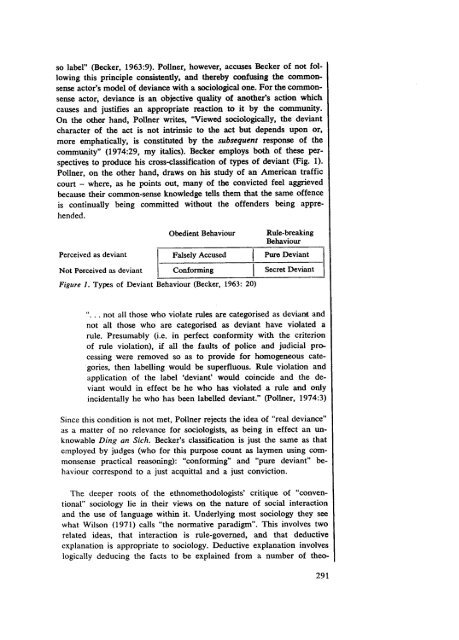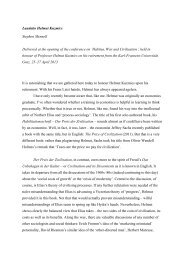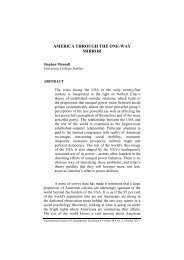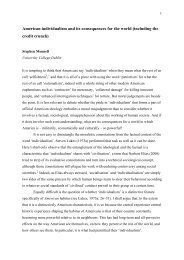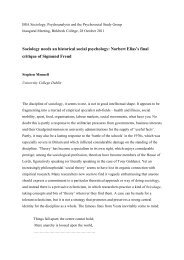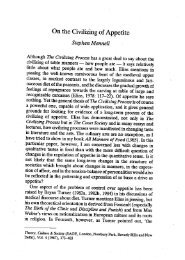Ethnomethodology and the New "Methodenstreit" - Stephen Mennell
Ethnomethodology and the New "Methodenstreit" - Stephen Mennell
Ethnomethodology and the New "Methodenstreit" - Stephen Mennell
You also want an ePaper? Increase the reach of your titles
YUMPU automatically turns print PDFs into web optimized ePapers that Google loves.
so label" (Becker, 1963:9). Pollner, however, accuses Becker of not followingthis principle consistently, <strong>and</strong> <strong>the</strong>reby confusing <strong>the</strong> commonsenseactor's model of deviance with a sociological one. For <strong>the</strong> commonsenseactor, deviance is an objective quality of ano<strong>the</strong>r's action whichcauses <strong>and</strong> justifies an appropriate reaction to it by <strong>the</strong> community.On <strong>the</strong> o<strong>the</strong>r h<strong>and</strong>, Pollner writes, "Viewed sociologically, <strong>the</strong> deviantcharacter of <strong>the</strong> act is not intrinsic to <strong>the</strong> act but depends upon or,more emphatically, is constituted by <strong>the</strong> subsequent response of <strong>the</strong>community" (1974:29, my italics). Becker employs both of <strong>the</strong>se perspectivesto produce his cross-classification of types of deviant (Fig. 1).Pollner, on <strong>the</strong> o<strong>the</strong>r h<strong>and</strong>, draws on his study of an American trafficcourt - where, as he points out, many of <strong>the</strong> convicted feel aggrievedbecause <strong>the</strong>ir common-sense knowledge tells <strong>the</strong>m that <strong>the</strong> same offenceis continually being committed without <strong>the</strong> offenders being apprehended.Obedient BehaviourRule-breakingBehaviourPerceived as deviant Falsely Accused Pure DeviantNot Perceived as deviant Conforming Secret DeviantFigure 1. Types of Deviant Behaviour (Becker, 1963: 20).... not all those who violate rules are categorised as deviant <strong>and</strong>not all those who are categorised as deviant have violated arule. Presumably (i.e. in perfect conformity with <strong>the</strong> criterionof rule violation), if all <strong>the</strong> faults of police <strong>and</strong> judicial processingwere removed so as to provide for homogeneous categories,<strong>the</strong>n labelling would be superfluous. Rule violation <strong>and</strong>application of <strong>the</strong> label 'deviant' would coincide <strong>and</strong> <strong>the</strong> deviantwould in effect be he who has violated a rule <strong>and</strong> onlyincidentally he who has been labelled deviant." (Pollner, 1974:3)Since this condition is not met, Pollner rejects <strong>the</strong> idea of "real deviance"as a matter of no relevance for sociologists, as being in effect an unknowableDing an Sich. Becker's classification is just <strong>the</strong> same as thatemployed by judges (who for this purpose count as laymen using commonsensepractical reasoning): "conforming" <strong>and</strong> "pure deviant" behaviourcorrespond to a just acquittal <strong>and</strong> a just conviction.The deeper roots of <strong>the</strong> ethnomethodologists' critique of "conventional"sociology lie in <strong>the</strong>ir views on <strong>the</strong> nature of social interaction<strong>and</strong> <strong>the</strong> use of language within it. Underlying most sociology <strong>the</strong>y seewhat Wilson (1971) calls "<strong>the</strong> normative paradigm". This involves tworelated ideas, that interaction is rule-governed, <strong>and</strong> that deductiveexplanation is appropriate to sociology. Deductive explanation involveslogically deducing <strong>the</strong> facts to be explained from a number of <strong>the</strong>e-291


